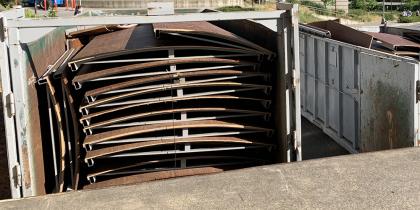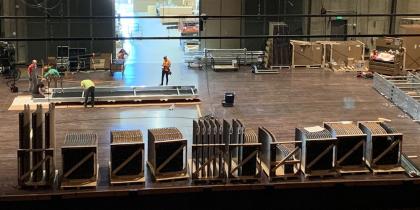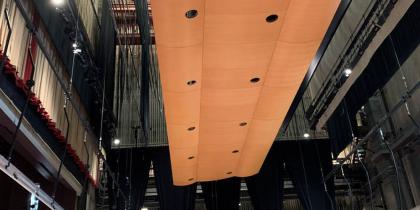You are here
Shell Game
Out with the old (photo: Tom Burke)
When Cuarteto Latinoamericano performs at Meany Center on October 7, it won’t just be the musicians who are making their debut on our stage. This will be the first performance for our new orchestra shell, as well.
After nearly 50 years, the old shell has been retired. Over the decades, the ceiling panels warped, sundry pieces of the structure were lost, and putting it together and then taking it apart before and after performances was both onerous and time-consuming. Not surprising, since its life expectancy was only meant to be about 20 years. Out with the old and in with new!
Audiences will notice some differences even before the music starts — the new shell is a much lighter shade, allowing performers to stand out against the background. The lights will be very different, too; the old shell had two settings: on and off. This one allows lighting to be adjusted and there are options for color. The walls and ceiling will match (unlike the old one) making it visually less distracting and finally, the walls fit snugly together, allowing no light to seep through from backstage. Of course, the main purpose of an orchestra shell is to offer the best acoustics, and this one promises to do its job very well.
In with the new (photo: Tom Burke)
Speaking of backstage, that’s where the shell will live for most of its non-performing life, folded neatly into nine giant towers that can be rolled on and off stage, and with the ceiling panels stored in the flys above the stage. It will take less than an hour to assemble before a performance.
Of course, it took a lot longer to build, initially! Orchestra shells don’t come fully assembled, and this one’s parts arrived in three 53-foot trailers. After spending nearly a week demolishing the old shell, it took more than two weeks to build the new one. This not only entailed putting the pieces together but also required new hangers and rigging for the ceiling. For this we turned to the shell’s manufacturer, Wenger Corporation.
The job fell to a man uniquely suited to aerial work. Nick Winn works for Wenger now, installing theater rigging but he grew up the seventh generation of a circus family that traveled the world performing highwire acts. By the time he was two, Nick was learning to walk on a wire; by the time he was a teenager, he was riding a motorcycle 300 feet up in the air on a cable — without nets or safety harness.
Our new ceiling flies through the air with the greatest of ease (photo: Tom Burke)
During those times when the family wasn’t touring, he and his brothers worked as theater riggers. Nick continued to regularly perform until about eight years ago when he was offered a fulltime job with Wenger.
It’s a big change, Nick admits, but he’s still involved in the entertainment world, just in a different way. And he was still thinking like an artist as he assembled our new shell. “This shell is designed for acoustics,” he said. “But it’s also aesthetic — it adds to the theater. It’s a beautiful orchestra shell.”
We think our audiences will agree!




